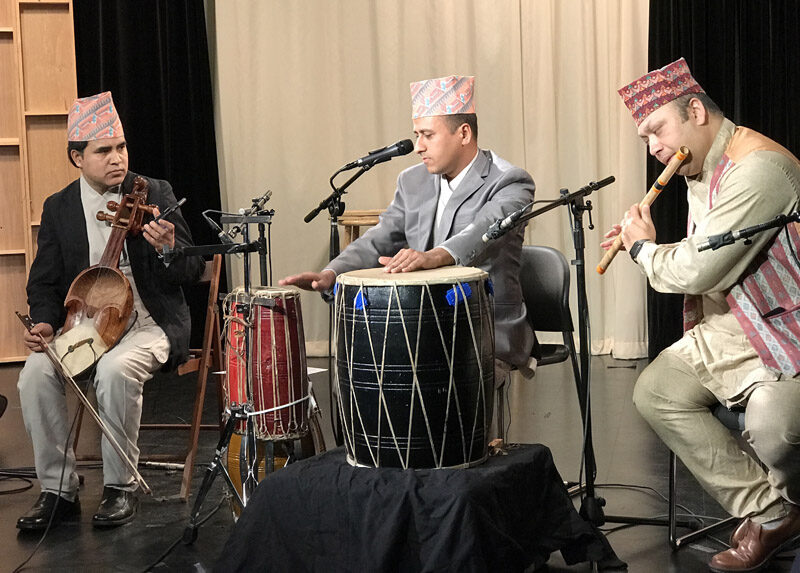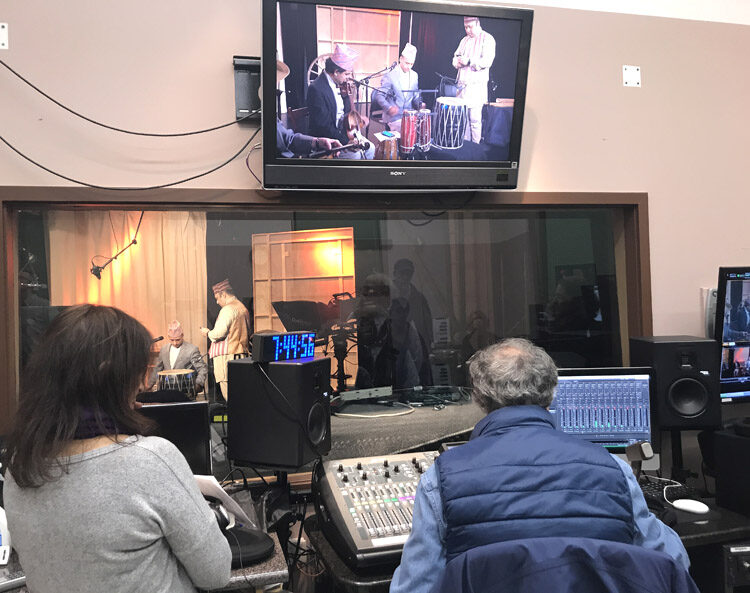Power of Culture Blog
138 Additional Cultural Sector Recovery Grants for Individuals Awarded
This $690,000 in awards completes the Agency’s COVID-19 relief grant making
Maggie Holtzberg, Folklorist

A couple of years ago, Alan Kaufman introduced me to Sushil Gautam, a Nepali immigrant he’d met at the local Dunkin Donuts in Arlington. It was Alan’s fiddle case that caught Sushil’s eye and the two struck up a conversation. Sushil, who had written a book on the Nepali sarangi (fiddle), was eager to meet an American fiddler. Today, the two have become friends and Sushil has moved on to work in information technology for a local healthcare company.
Last week, I was delighted that Alan invited me to the filming of In the Tradition, a studio show he writes and hosts at Arlington Community Media, Inc. The hour-long broadcast features local and visiting musicians. Recently, Alan has ventured beyond western traditional music. On the December 20, 2017 shoot, the featured guests were three local Nepali musicians: Shyam Nepali on sarangi, Sushil Gautam on jaw harp and madal, and Ranjan Budhathoki on flutes. Of the three, only one, Shyam Nepali, is a member of the Gandharba occupational caste of musicians. Historically, the Gandharba traveled from town to town in the mountainous regions of Nepal. Much like other hereditary musicians, they played a key role in society, traveling from village to village, spreading news and entertaining.

The tradition of playing the sarangi is associated with the Gandharba. Indeed, Shyam comes from a long line of traditional musicians, primarily sarangi players. His instrument was made by his brother and features a carved bird as a scroll. The sound box is covered with goat skin. Shyam explains that the string is played by placing the fingernail (rather than the pad of the finger) on the metal strings. Although he uses a western style violin bow, traditionally, the bow was made from bamboo strung with soaked cactus fiber instead of horse hair.

But I’m getting ahead of myself. . .
We all arrived around 6:00 p.m. at Arlington Community Media, Inc., the local cable television station. It being late December, it was already dark and cold. After unloading musical instruments in “Studio A,” everyone gathered downstairs for pizza while Alan went over production notes.

Alan joked with us about how when he picked up the pizza, he mentioned to the take-out staff it was for some Nepali musicians who were going to be performing on his show. “Oh, who?” they responded. Turns out they were from Nepal as well –Greater Boston’s Nepalese version of serial migration.
Once back up in the studio, it was time to tune up the musical instruments, check mic levels, and go over the script.

In addition to the interview-style chat led by Alan, the group performed a number of songs and instrumentals.
Shyam Nepali and Ranjan Budhathoki grew up together in the Kathmandu, Nepal. Ranjan, whose family’s home was farther from the school they both attended, would often go to Shyam’s home. It was a welcoming and musical household. Sushil Gautam grew up 200 kilometers away in Pokhara where he was hypnotized by the music of he Gandharba people. Usually the sarangi is only taught within the occupational caste. However, Sushil’s parents supported him in learning to play the music. It was not common for someone outside the Gandharba community to learn sarangi. He eventually moved to Kathmandu, where he had the luck to rent a house next door to Shyam Nepali.
At the time, he had just started to play the flute, having fashioned one out of small bamboo growing in the back yard. Ranjan went on to become a professional dancer and teacher of dance in Nepal. He and Shyam emigrated to Massachusetts within a few years of each other. When Shyam arrived, the two said, “Why don’t we start a school here? Our population is growing, the children are missing the connection to our Himalayan culture.” Both currently teach at the school they established, the Himalayan Heritage Cultural Academy in Medford, MA.
Shyam spoke of the relationship between the music of Nepal and Southern Appalachia, both being mountainous regions. He recalled first hearing old time and bluegrass music and being blown away by the similarities. Alan and these three Nepali musicians have found common ground, swapping and sharing tunes like the classic, “Cluck Old Hen.”
If you are curious to hear this music live, head over to Chulo Cuisine & Bar, a recently opened Nepalese restaurant located at 5 Spring Street (upstairs) in Watertown Square. They perform Friday, Saturday, and Monday evenings. And be sure to watch for the upcoming Nepali feature on In the Tradition.
This blog post originally appeared on our Keepers of Tradition blog on December 27, 2017.